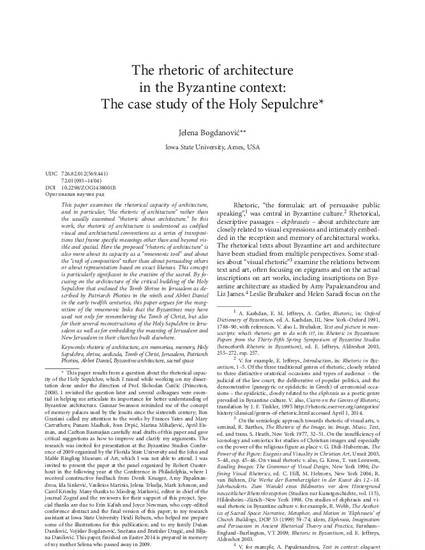
Article
The rhetoric of architecture in the Byzantine context: The case study of the Holy Sepulchre / Реторика архитектуре у византијском контексту: пример цркве Светог гроба
Zograf / ЗОГРАФ
Document Type
Article
Disciplines
Publication Version
Published Version
Publication Date
1-1-2014
DOI
10.2298/ZOG1438001B
Abstract
This paper examines the rhetorical capacity of architecture, and in particular, “the rhetoric of architecture” rather than the usually examined “rhetoric about architecture.” In this work, the rhetoric of architecture is understood as codified visual and architectural conventions as a series of transpositions that frame specific meanings other than and beyond visible and spatial. Here the proposed “rhetoric of architecture” is also more about its capacity as a “mnemonic tool” and about the “craft of composition” rather than about persuading others or about representation based on exact likeness. This concept is particularly significant in the creation of the sacred. By focusing on the architecture of the critical building of the Holy Sepulchre that enclosed the Tomb Shrine in Jerusalem as described by Patriarch Photios in the ninth and Abbot Daniel in the early twelfth centuries, this paper argues for the recognition of the mnemonic links that the Byzantines may have used not only for remembering the Tomb of Christ, but also for their several reconstructions of the Holy Sepulchre in Jerusalem as well as for embedding the meaning of Jerusalem and New Jerusalem in their churches built elsewhere.
--
Реторички описни текстови о архитектури го- воре о значају визуелног изражавања и саставни су део рецепције појединих архитектонских објеката и сећања на њих у византијској култури. Коришћењем архитектуре за епистемолошко разумевање визан- тијске културе могуће је испитати реторику архи- тектуре уместо реторику о архитектури, то јест описивање архитектуре у тексту. У овом раду под ре- ториком архитектуре подразумева се серија кодифи- кованих визуелних и архитектонских конвенција које путем низа транспозиција стварају оквире особених значења што надилазе видљиве и просторне аспекте архитектуре. Tако схваћена, реторика архитектуре разматрана је више као потенцијал за успостављање меморијских веза важних за сећање на поједине архи- тектонске објекте и за вештину композиције него као реторичко пропагандно средство које једнозначно треба да убеди посматрача у значење објекта или као могућност прецизног копирања архитектуре на осно- ву тачно одређене форме.
Copyright Owner
Zograf
Copyright Date
2014
Language
en/sr
File Format
application/pdf
Citation Information
Jelena Bogdanović. "The rhetoric of architecture in the Byzantine context: The case study of the Holy Sepulchre / Реторика архитектуре у византијском контексту: пример цркве Светог гроба" Zograf / ЗОГРАФ Vol. 38 (2014) p. 1 - 21 Available at: http://works.bepress.com/jelena_bogdanovic/23/

This article was published in Zograf 38 (2014): 1–21, doi:10.2298/ZOG1438001B. Posted with permission.